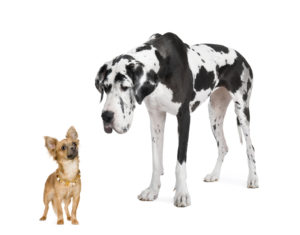 Is one-of-a-kind diversity a contradiction in terms? No, that’s just dogs for you. Canis familiaris is the only species on the planet that contains the extreme variety of the Great Dane and the Chihuahua, the Dachshund and the Rottweiler, the Yorkshire Terrier and the Bernese Mountain Dog. There are, give or take a few, four hundred breeds within this one species. We dog lovers like to think we know why this has happened. It’s the dog-human thing. The special bond, the partnership that has had people and pooches sharing campfires for at least 15,000 years. (Possibly much longer: A study by evolutionary biologist Robert Wayne suggests humans domesticated dogs as long ago as 40,000 years.)
Is one-of-a-kind diversity a contradiction in terms? No, that’s just dogs for you. Canis familiaris is the only species on the planet that contains the extreme variety of the Great Dane and the Chihuahua, the Dachshund and the Rottweiler, the Yorkshire Terrier and the Bernese Mountain Dog. There are, give or take a few, four hundred breeds within this one species. We dog lovers like to think we know why this has happened. It’s the dog-human thing. The special bond, the partnership that has had people and pooches sharing campfires for at least 15,000 years. (Possibly much longer: A study by evolutionary biologist Robert Wayne suggests humans domesticated dogs as long ago as 40,000 years.)
Because of this connection, we have been breeding dogs to meet our work and leisure needs for several millennia. Collies and Kelpies to herd our sheep, Huskies to pull our sleds, Afghan Hounds and Basenjis to help us hunt. And humans are obviously a large part of the reason dogs are so diverse today. Another part is natural selection. For example, dogs tend to grow larger in northern climes to cope with the cold. But that still leaves unanswered the question of how it’s possible. Why, of all creatures, do dogs have plastic DNA, the kind that allows for the deliberate cultivation of digging skills, longer noses, or skin folds that capture smell molecules? And how is it possible to make these changes so quickly? In just a few generations, we have created dogs that are wildly divergent in type and ability.
Nobody has the answer yet. Some favor the idea of an accident of evolution: Elephants have trunks, dogs have malleable DNA. Another theory is that it’s a survival skill, developed in the course of the time dogs have been in contact with humans. Look at the evidence. There are an estimated 900 million dogs in the world today. Compare this with the estimated 200,000 wolves left in the wild and it’s hard to deny that dogs as a subspecies possess a genius for survival.

